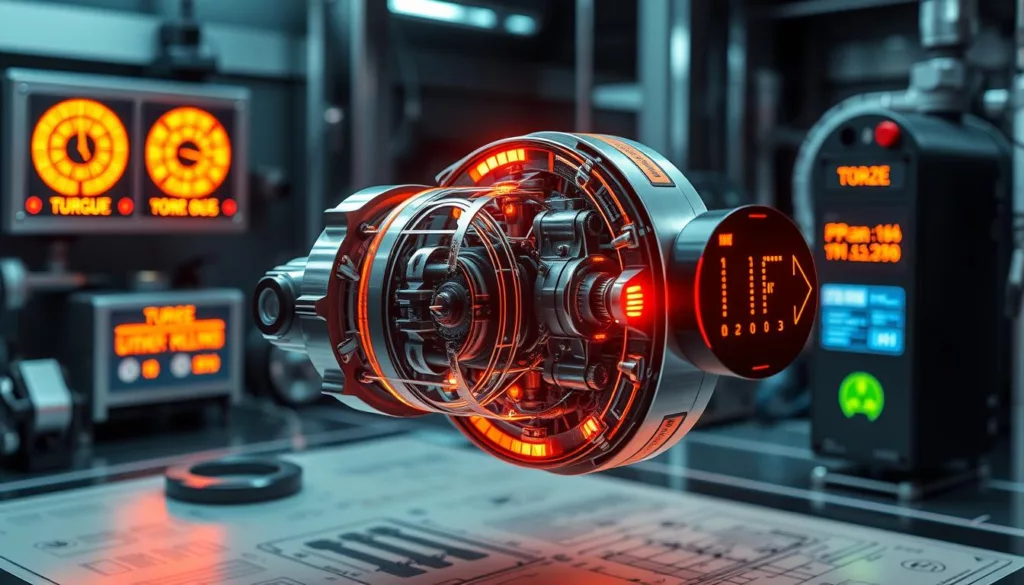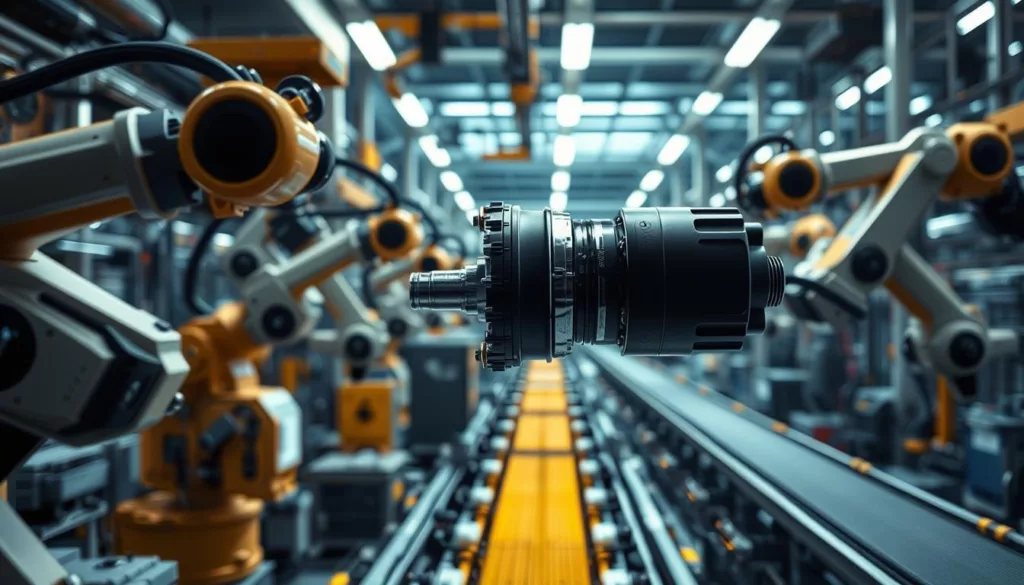The world of industrial automation and robotics needs precise tools. These tools must measure different physical forces accurately. The 4-axis transducer sensor with torque is a new solution that’s changing how industries measure and control forces.
XJCSENSOR created this advanced sensor. It can detect four independent axes of force. This means it can monitor stresses and torque in all directions. The sensor’s latest technology makes it very accurate and versatile, useful for many industrial tasks.
Key Takeaways
- Comprehensive 4-axis force and torque measurement in a single sensor solution
- Exceptional precision and sensitivity for demanding industrial applications
- Versatile design accommodates a variety of robotic and automation systems
- Robust construction and environmental resilience for reliable performance
- Streamlined integration and customization options to meet specific requirements
The 4-axis transducer sensor from XJCSENSOR is a big step forward in automation and robotics. It combines precise engineering with advanced sensing. This makes it a key player in changing how industries measure and control forces.
Understanding Multi-Axis Force Measurement Technology
In the world of precision, multi-axis force measurement technology is key. It’s used in many areas like robotics and quality control. It helps ensure things work well and efficiently.
Basic Principles of Force Detection
Force detection in multi-axis systems works by measuring how things bend when forces are applied. Torque transducers are used to find out how strong and in what direction these forces are. This gives a full picture of what’s happening.
Components of Multi-Axis Systems
- Sensor elements: These are things like strain gauges or piezoelectric crystals. They turn physical forces into signals.
- Signal conditioning: This part gets the sensor data ready for computers to use. It includes things like converters and filters.
- Data processing: This is where the magic happens. Algorithms and software make sense of the data, showing the forces in all directions.
Signal Processing in Force Measurement
The core of multi-axis precision instrumentation is in how it processes signals. It uses advanced techniques like filtering and calibration. This makes sure the data is accurate and reliable, helping control systems work better.
“The ability to accurately measure and respond to multi-dimensional forces is the foundation of modern industrial automation and robotics.”
Knowing how multi-axis force measurement works helps engineers and technicians. It lets them use these systems to their fullest, leading to new ideas and better performance in many fields.
4-Axis Transducer Sensor with Torque: Core Features and Benefits
XJCSENSOR’s 4-axis transducer sensors are a powerful tool for rotational torque sensing, force measurement, and more. They give accurate data on forces and torque in multiple directions. This helps control, monitor, and improve many industrial processes.
The main features and benefits of XJCSENSOR’s 4-axis transducer sensors are:
- They measure forces and torque in four directions at once.
- They detect forces very well with little to no interference.
- They are built to last, even in tough environments.
- They work well with industrial control systems and automation.
- They can be customized to fit your needs.
These advanced sensors help users understand their processes better. They improve productivity and quality control by measuring force and torque precisely. XJCSENSOR’s 4-axis transducers give real-time data across multiple axes. This helps customers make better decisions and improve their operations continuously.
“The 4-axis transducer sensors from XJCSENSOR have been a game-changer for our robotic assembly line. The high-precision force measurement and torque sensing capabilities have allowed us to optimize our processes, reduce waste, and consistently deliver the quality our customers expect.”
Design Architecture and Sensing Elements
The heart of XJCSENSOR’s 4-axis transducer sensors is their advanced design and precision. These torque transducer solutions use the latest in strain gauge tech. They make accurate force measurement in multiple axes possible.
Strain Gauge Configuration
The way we arrange the strain gauges in our transducer sensors is key. It’s designed for top performance and reliability. This setup lets us capture detailed forces and moments. We then turn these into electrical signals for exact control and analysis.
Material Selection and Construction
Choosing the right materials is essential for our precision instrumentation. From the base structure to the coatings, every part is picked with care. This ensures our sensors can handle the needs of different industries.
Calibration Methods
Our sensors’ accuracy and reliability are our main focus. We use advanced calibration methods, like multipoint calibration and temperature compensation. This way, we provide consistent, reliable force measurement data to our customers.
“XJCSENSOR’s commitment to engineering excellence is reflected in the design and construction of our 4-axis transducer sensors, empowering our customers with the precision and reliability they demand.”
Industrial Applications and Use Cases
At XJCSENSOR, our 4-axis transducer sensors are key in many industries. They help in manufacturing, quality control, and research. These sensors are changing how things are done in many areas.
In industrial automation, our sensors are vital. They help monitor and improve robotic systems. They measure forces and torques, making sure robots work well and efficiently.
- Robotic assembly line optimization
- Automated material handling and packaging
- Robotic welding and inspection processes
Our sensors also help in quality control and research. They give accurate data for testing products. This helps keep quality high and cuts down on defects.
“The versatility of XJCSENSOR’s 4-axis transducer sensors has been a game-changer in our quality control processes. The precise force and torque measurements have helped us identify and address issues earlier, leading to significant improvements in product quality and operational efficiency.”
– [Name], Quality Assurance Manager, [Company]
In research, these sensors collect and analyze data. They help engineers and scientists understand physical phenomena better. This leads to better designs.
Across many industries, XJCSENSOR’s sensors are changing how things are done. They offer precise, reliable, and versatile solutions. This helps our customers improve efficiency, quality, and innovation.
Integration with Robotics and Automation Systems
Industrial robotics and automation are changing how we make things. Our 4-axis transducer sensors are key in this change. They help robots work better, making robotics integration, industrial automation, and process control more precise.
Robot End-Effector Implementation
Our sensors are put at the robot’s “hand.” This lets robots handle things more carefully. It also gives real-time data for better monitoring and improvement.
Control System Integration
We focus on making our sensors work well with control systems. This lets manufacturers control their processes better. It makes automation more flexible and efficient.
Performance Optimization
- Enhance end-effector precision and stability through accurate force and torque feedback
- Improve product quality and reduce defects by closely monitoring and adjusting production parameters
- Increase overall equipment effectiveness (OEE) and operational efficiency by optimizing robotic and automation processes
Our 4-axis transducer sensors help manufacturers reach new heights in industrial automation. This leads to better productivity, quality, and competitiveness.
XJCSENSOR’s Advanced Transducer Solutions
At XJCSENSOR, we aim to provide top-notch transducer solutions for our industrial clients. We focus on 4-axis transducer sensors with torque, precision, and advanced force measurement. This makes us stand out in the market.
Our team of engineering experts uses the latest research and development. They design and make high-quality transducers. These transducers boost productivity, accuracy, and automation in various tool applications.
Our 4-axis transducer sensors combine strain gauge, selected materials, and advanced calibration. This ensures they perform at the highest level. Our focus on precision and force measurement helps our customers reach new quality and control levels.
“XJCSENSOR’s innovative approach to transducer solutions has been a game-changer for our manufacturing processes. The accuracy and responsiveness of their sensors have significantly improved our productivity and product quality.”
– Industrial Automation Manager, Automotive Manufacturer
We understand our clients’ evolving needs deeply. We invest in research and development to lead in sensor technology. This keeps our solutions adaptable and future-proof.
Partnering with XJCSENSOR means working with a team of technical experts. They are committed to delivering customized, high-performance transducer solutions. Experience our advanced transducer technology and unlock new business possibilities.
Precision and Accuracy Considerations
At XJCSENSOR, we know how important precision and accuracy are. Our 4-axis transducer sensors are made to be reliable and consistent. We focus on error compensation, environmental factors, and maintenance to make sure they work well.
Error Compensation Techniques
Our engineers use advanced algorithms to reduce errors. These include temperature changes, hysteresis, and non-linearity. This way, our sensors give precise and steady measurements, even in tough conditions.
Environmental Impact Factors
Environmental conditions can affect sensor performance. We choose materials and build our sensors to handle temperature, humidity, and vibration. This means our customers get accurate and stable readings, no matter the environment.
Maintenance Requirements
Maintaining sensors is key to keeping them precise and accurate. XJCSENSOR offers detailed guidance and support. We help our customers integrate and maintain our sensors, ensuring they work well over time. This helps avoid unexpected downtime and keeps data reliable for monitoring and control.
| Parameter | Specification |
|---|---|
| Measurement Range | ±100 N |
| Accuracy | ±0.5% of full scale |
| Resolution | 0.01 N |
| Repeatability | ±0.1% of full scale |
| Operating Temperature | -10°C to 50°C |
“XJCSENSOR’s commitment to precision and accuracy is unparalleled, ensuring our clients can trust the data from their condition monitoring and process control systems.”
Data Acquisition and Processing Methods
The advanced 4-axis transducer sensors from XJCSENSOR offer detailed force measurement and multi-axis sensing. We’ve developed strong data acquisition and processing methods. These help us handle complex multi-axis signals well, improving process control and decision-making in many industries.
We focus on capturing high-resolution data, keeping every detail of force and torque measurements. Our special signal processing algorithms then find important insights from these inputs. Advanced analytics and machine learning help spot patterns, trends, and oddities that manual checks might miss.
Our multi-axis sensing solutions work well with industrial control systems and automation platforms. This integration makes real-time data processing and feedback loops possible. It allows for quick adjustments to improve manufacturing, product quality, and efficiency.





